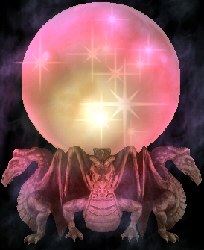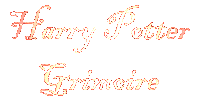Cat - the cat, domesticated for perhaps five thousand years, has long been associated with magic. This nocturnal creature was (and is) linked to the moon, the supernatural, and darkness.
Ancient Egyptians were the first to domesticate cats, and India also worshipped them long, long ago. The city of Bubasti, once Egypt's capital, was devoted to worshipping Bast, a cat-headed goddess. Around 2000 B.C., Bastet was first revered as the embodiment of fertility and healing. The Greek historian, Diodorus Siculus, reported that temple cats were pampered with meals of milk and bread and fish from the Nile. Such was their importance that even their caretakers attained high status in the community. Cats eventually came to be regarded as gods themselves, and to kill one (even by accident) was punishable by death. When the family cat died, the members of its household shaved their eyebrows as a symbol of their mourning. Cats were buried with the utmost respect, being mummified.
Ancient Europe also honored the cat. Romans believed the goddess Diana could transform herself into a cat. The Norse goddess of love, marriage and fertility -- Freya -- traveled in a chariot drawn by a pair of felines. Early Britains also honored the cat.
With the advent of Christianity, however, reverence was replaced by fear and superstition. The cat came to be regarded as companions to witches. Like Mrs. Norris, they were said to communicate with their owners. Some believed that cats weren't witch's spies, but were actually witches themselves. However, the most popular role was that of familiar, a minor demon provided by the Devil to perform evil deeds for the witch.
While Americans can shun black cats, the English consider them lucky. According to Welsh tradition, those who keep both a black cat and a white, are the luckiest of all.
Catoptromancy - divining the future by looking into a mirror. See Divination
Cauldron - every witch and wizard owns at least one cauldron, which are used to brew potions, predict the future, provide food, grant youth and strength, and/or bestow wisdom. The cauldron is available in many sizes and shapes. They can be made of various elements, including stone, bronze, pewter, copper and cast iron.
Cauldrons were important in religious rituals. Ancient Celts pacified their gods by offering gold and silver jewelry in the cauldron, which they sunk in a body of water. The Celts, Irish and Welsh all believed the cauldron held power over life itself. The mouth of the cauldron is the gateway to the underworld, from whence new life emerges and to which the dead return.
During the Middle Ages, the cauldron was a pivotal part of life, used for cooking, brewing medicine, doing laundry and dyeing clothes, making candles and soap, and also for transporting fire and water.
But cauldrons are best known as tools for witches. Medea, of Greek mythology, used one to make a magical brew that restored her aging father-in-law to youth. And of course, the witches in Macbeth were chanting around a cauldron. "Trouble, trouble, toil and bubble. . ."
Centaur - a creature from classical mythology, half man and half horse. Their upper bodies and heads are human and they retain their arms, while their legs and bodies are horse. Centaurs are private, mysterious beings, choosing to avoid muggles and wizards alike. Some of them live in the Forbidden Forest, where they watch and divine the signs in the stars and planets.
The centaurs of Greek mythology were a rowdy lot who liked their wine. They lived in herds in the mountains of northern Greece, pursuing a wild and lawless lifestyle. Centaurs were beautiful, but always ready to drink, fight and seduce human women. They fought battles with humans. Some centaurs, however, rebelled against the wild ways of their kin, preferring both virtue and scholarly contemplation over carousing and conflict. Chiron is the most well-known of these. He was a teacher/mentor to many, including Hercules, Achilles (hero of the Trojan war), Jason (captain of the Argo, and seeker of the golden fleece), and Asclepius (god of medicine). Being wise and just, Chiron practiced his skills in medicine, the hunt, herbology, celestial navigation, and astrological divination.
Chiron was born an immortal yet he didn't live forever. Hercules wounded him accidentally with a poisoned arrow. The pain was unbearable, and Chiron asked Zeus to let him die. Zeus granted the wish, and then made Chiron immortal in a different way, placing him amongst the lofty stars as the constellation Centaurus, one of the brightest in the Southern Hemisphere. One of its stars, Alpha Centauri, is the closest star to our own solar system. Some muggles claim that Chiron became the constellation Sagittarius. Either way, it's a beautiful tribute to be remembered in the night sky.
Cerberus - according to the Greek and Roman legend (dating back some three thousand years), this son of a fire-breathing giant covered in snakes, and a half-woman, half-serpent who ate men raw, was a three-headed, dragon-tailed dog guarding the entrance to Hades. All spirits were let into the underworld, but Cerberus would not allow any to leave. Some did manage to escape, notably Orpheus, a talented musician who charmed the beast with his lyre.
For a while, Hercules captured the great beast and took him to the world above. While in the land of the living, Cerberus drooled upon the earth. Where his saliva fell, poisonous aconite grew. Also known as wolfsbane, aconite was commonly used in the potions and ointments of fictional and real witches.
Ceromancy - an ancient form of Divination of slowly pouring wax melted in a brass bowl into another bowl filled with cold water. The congealed shapes were then interpreted by the seer.
Chameleon Ghoul - see Ghoul
Charm - derived from an old Latin word for "song" or "ritual utterance," a charm is any formula, act, or object that has the magical power to ward off danger or to promote good luck. The word originally meant the chanting of a verse and also came to mean an object worn or carried for protection or luck, much like an amulet.
Chimera (Chimaera) - from Greek mythology, a fire-breathing she-monster that has a lion's head, goat's body and a serpent's tail.
Chinese Fireball (Dragons) - a dragon with smooth scales, colored scarlet with a fringe of gold spikes encircling its face. Its protruberent eyes are set about a snubby snout. They weigh between two to four tons and produce a mushroom-shaped flame. Their crimson eggs are flecked with gold, a shell very highly prized by Chinese wizards. The Fireball eats most mammals, especially favoring pigs and humans.
Chiromancy - reading the lines of the palm to divine the future, or Palmistry. See Divination
Chizpurfle - small crablike parasites about a twentieth of an inch high. It has large fangs for its size. Magic attracts these pests. They infest live creatures, living in feathers or fur, or they attack magical objects like wands, gnawing through to the core of magic within. They are often found in dirty cauldrons, gorging on drops of potion left behind by the careless wizard. Patented potions will usually eliminate a chizpurfle infestation.
Christmas - A form of Divination that originated in Russia, performed at the time of the winter solstice. In a dark room, two lit candles and a pair of mirrors are positioned so that one reflects candlelight into another. The seeker, typically a girl, would look at the seventh reflection in order to catch sight of her future.
Circe - according to Greek mythology, Circe was a great, charming and cruel witch who changed men into animals, could make forests change locations, and she turned day into night. A few ancient writers chronicled her story, such as Hesiod, Plutarch, Ovid, and of course, Homer, when he wrote about Odysseus and his crew of sailors landing upon Circe's island. She turned his men into pigs and planned to do the same to Odysseus. However, while he was on his way to find his men, he was met by the god, Hermes, who gave him moly (an herb) that neutralized her spells and potions. Circe took the graceful route of becoming a friend to Odysseus, once it became clear her magic was powerless against him. She returned his sailors to human form, and she even became his advisor. Circe foresaw the dangers ahead. She told Odysseus ways to communicate with ghosts he would meet during his journey to the underworld.
Clabbert - the American south is the clabbert's original home. It now exists in trees worldwide, looking like a cross between a monkey and a frog. It is characterized by smooth, mottled green skin, webbed hands and feet, and long limbs which enable it to easily swing from branch to branch. There are short horns on its head. Razor sharp teeth fill its wide mouth, which appears to be grinning in macabre fashion. Its most noticable feature is a large pustule centered on its forehead. The pustule flashes and turns bright red when the creature senses danger.
Clauricorn - see Leprechaun
Colloportus (Spell) - a spell which seals doors.
Common Welsh Green (Dragons) - from Wales, a verdant green like the grass of its native country, this dragon possesses a melodius roar. Its fire is exhaled in thin jets. The eggs are an earthy brown color and speckled with green. Its preferred prey is sheep.
Confundus (Spell) - a charm that creates confusion.
Conjectivitus (Spell) - to curse another's eyes into blurred vision.
Cornish Pixies - see Pixie
Cruciatus Curse (Spell) - the second of the three Unforgivable Curses. Cruciatus causes intense, unimaginable pain in the victim.
Crup - originally from the southeast of England, crups look like a Jack Russell terrier, except for their forked tails (which are removed with a painless severing charm when the crup is a six to eight week old pup to keep muggles from noticing it). This dog must be a wizard creation because of its fierce loyalty to wizards and its intense dislike of muggles.
Crystal Ball - a clear sphere, first used in the Middle Ages, in which one sees visions. See Divination
Crystalomancy (Divination) - gazing into natural or polished crystal in an attempt to see the future
Curse - one of the most powerful, dangerous forms of magic, an appeal to the supernatural to bring pain, suffering, illness and even death to the enemy. See Dark Arts/Black Magic. See Spell
Cushioning Charm - a spell invented by Elliot Smethwyk in 1820, which allows the rider of a broom to float above the handle rather than actually sitting on it. See Broomstick



